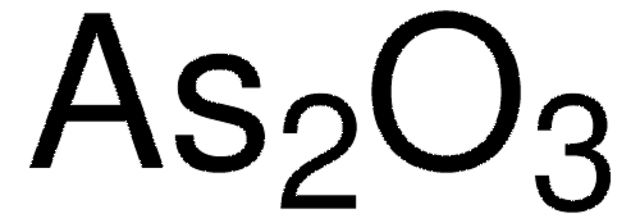202673
Arsenic(III) oxide
99.995% trace metals basis
Sinónimos:
ATO, Diarsenic trioxide;, Arsenic trioxide, Arsenous acid
About This Item
Productos recomendados
Quality Level
assay
99.995% trace metals basis
form
powder
reaction suitability
core: arsenic
reagent type: catalyst
SMILES string
O=[As]O[As]=O
InChI
1S/As2O3/c3-1-5-2-4
InChI key
IKWTVSLWAPBBKU-UHFFFAOYSA-N
¿Está buscando productos similares? Visita Guía de comparación de productos
Categorías relacionadas
General description
Application
- Electrochemical detection applications: A study on La-based perovskites incorporated with functionalized carbon nanofibers highlights the use of arsenic trioxide for the electrochemical detection of roxarsone in water and food samples, providing a method to improve safety and environmental monitoring (John Felix MA et al., 2024).
- Antiproliferative effects in cancer research: Research demonstrates the inhibitory effects of arsenic trioxide, combined with metformin, on KG1a cell proliferation, suggesting its potential utility in developing antineoplastic strategies (Huang-Li WH et al., 2024).
- Environmental remediation: A review on manganese oxide-based materials for arsenic removal discusses the application of arsenic trioxide in environmental remediation, focusing on the effectiveness and advancements in arsenic decontamination technologies (Younas M et al., 2024).
signalword
Danger
hcodes
Hazard Classifications
Acute Tox. 2 Oral - Aquatic Acute 1 - Aquatic Chronic 1 - Carc. 1A - Eye Dam. 1 - Skin Corr. 1B - STOT RE 1
target_organs
Respiratory system,Cardio-vascular system,Gastrointestinal tract
Storage Class
6.1A - Combustible acute toxic Cat. 1 and 2 / very toxic hazardous materials
wgk_germany
WGK 3
flash_point_f
Not applicable
flash_point_c
Not applicable
ppe
Eyeshields, Faceshields, Gloves, type P3 (EN 143) respirator cartridges
Elija entre una de las versiones más recientes:
¿Ya tiene este producto?
Encuentre la documentación para los productos que ha comprado recientemente en la Biblioteca de documentos.
Global Trade Item Number
| Número de referencia del producto (SKU) | GTIN |
|---|---|
| 202673-5G | 4061838765154 |
| 202673-25G | 4061838765147 |
Nuestro equipo de científicos tiene experiencia en todas las áreas de investigación: Ciencias de la vida, Ciencia de los materiales, Síntesis química, Cromatografía, Analítica y muchas otras.
Póngase en contacto con el Servicio técnico









